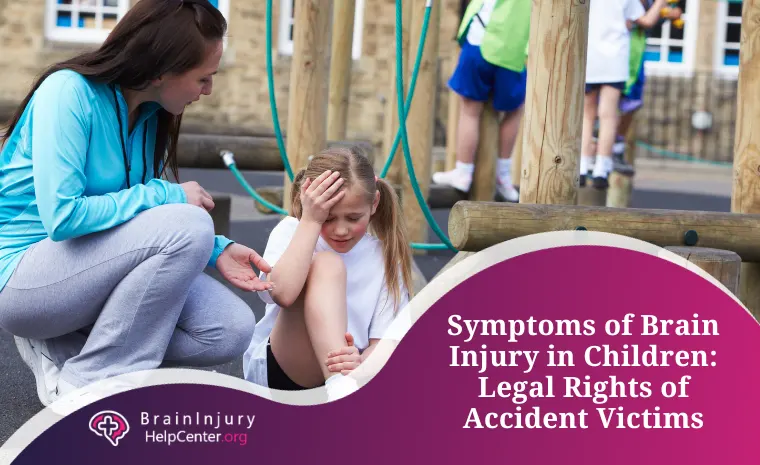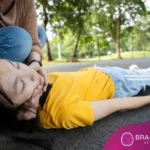Symptoms of Brain Injury in Children: Legal Rights of Accident Victims
Brain injuries can be a devastating consequence of accidents, and when it comes to children, the stakes are even higher. Children are more vulnerable to the effects of brain injuries, and their symptoms can differ significantly from those seen in adults.
In this blog, we will explore the symptoms of brain injury in children, how to recognize them, and the long-term consequences. Additionally, we will look into the legal rights of child accident victims in California, including the possibility of personal injury claims and what makes child injury claims unique.
Did your child suffer brain injury symptoms due to an accident? We can help you get compensation.
Understanding Brain Injuries
A head injury encompasses any harm inflicted upon the scalp, skull, brain, or associated tissues and blood vessels within the head. Depending on the severity of the injury, it may also be referred to as a traumatic brain injury (TBI).
A head injury can manifest as a minor occurrence, such as a bump, bruise (contusion), or laceration on the head. Conversely, it can manifest as a concussion, a profound laceration or open wound, fractured skull bones, internal bleeding, or damage to the brain itself. Head injuries stand as one of the leading causes of disability and fatalities among children.
Concussion
A concussion is a type of injury that can temporarily disrupt normal brain function. It may lead to a brief loss of consciousness or alertness, ranging from a few moments to several hours. Some concussions are mild and of short duration, and their presence may not be immediately apparent.
Contusion
A contusion refers to a bruise that occurs within the brain. It results from bleeding and swelling in the brain tissue around the area impacted by a blow to the head. Sometimes, this minor head injury can develop on the opposite side of the head due to the brain’s contact with the skull. This injury can be caused by a direct head injury, shaken baby syndrome, or a whiplash-type injury from a motor vehicle accident. The forceful movement of the brain against the skull’s interior can lead to tearing of the brain’s internal lining, tissues, and blood vessels.
Skull Fracture
A skull fracture is a break in the bone of the skull. There are four primary types of skull fractures:
- Linear Skull Fracture: This type of fracture involves a break in the bone that does not displace the bone. Typically, children with a linear skull fracture are closely monitored in the hospital for a brief period, and they can often resume normal activities within a few days. Treatment is usually unnecessary.
- Depressed Skull Fracture: In this fracture, a portion of the skull bone is depressed or sunken where the fracture occurs. This may or may not be accompanied by a scalp laceration. If the depressed bone exerts pressure on the brain, surgical intervention is required to correct it.
- Diastatic Skull Fracture: This fracture occurs along the suture lines of the skull, which are the irregular lines between the skull bones that fuse as a child grows. Diastatic fractures cause widening of these normal suture lines and are more commonly observed in newborns and infants.
- Basilar Skull Fracture: A basilar skull fracture is a break in the bone at the skull’s base and can be a severe type of skull injury. Children with this fracture often exhibit bruising around the eyes and behind the ears. Additionally, they may experience clear fluid drainage from the nose or ears due to a tear in the covering of the brain.
Traumatic Brain Injury (TBI)
Traumatic brain injury, or TBI, is the most common form of severe head injury and often involves a sudden, violent blow or jolt to the head. These injuries can result from car accidents, falls, sports-related incidents, or physical assaults. TBIs can lead to long-lasting or even permanent brain damage, affecting a child’s cognitive, emotional, and physical abilities. Recognizing and treating TBIs promptly is critical to minimizing their long-term impact.
Did your child get hurt because of another’s negligence? We can help you get compensation.
Causes of Brain Injury in Children
There are numerous factors that can lead to head injuries in children. Some prevalent causes include:
- Sports injuries
- Falls
- Involvement in a motor vehicle crashes or being hit by a vehicle while walking
- Incidents of child abuse
Identifying Symptoms of Brain Injury in Children
Recognizing the signs and symptoms of brain injury in children is crucial for early intervention and appropriate medical care. These symptoms may include:
- Changes in Behavior: Watch out for shifts in behavior such as irritability, mood swings, and increased agitation. Children might become more withdrawn or exhibit unusual temper tantrums.
- Cognitive Changes: Brain injury can affect a child’s memory, attention span, and ability to concentrate. Parents may notice a decline in academic performance or difficulty in processing information.
- Physical Symptoms: Headaches, nausea, vomiting, and dizziness are common physical symptoms of brain injury in children. Some children may also experience an increase in intracranial pressure, seizures, loss of consciousness, and severe headaches. An unstable blood pressure can also be one of the common symptoms.
- Coordination Issues: Motor skills may deteriorate, leading to problems with balance and coordination. Clumsiness or difficulty with fine motor tasks could be indicative of a brain injury.
- Speech and Language Problems: A child may have difficulty speaking, slurred speech, or problems understanding language.
- Sensory Changes: Changes in vision or hearing can occur following a brain injury. Children may report blurred vision, double vision, ringing in the ears, or sensitivity to light and noise.

Long-Term Complications
The long-term effects of brain injury in children can be profound. Some children may experience:
- Developmental Delays: Brain injuries can impede a child’s physical, cognitive, and emotional development.
- Learning Disabilities: Brain injuries may lead to learning disabilities, such as memory loss, that require specialized education and therapy.
- Emotional and Behavioral Issues: Children may struggle with mood disorders, anxiety, and depression due to the emotional impact of the injury.
- Social Challenges: Brain injuries can affect a child’s ability to form and maintain relationships with peers.
- Death in Children: Unfortunately, in some cases, severe injury to the head can cause untimely death to a child.
Legal Rights of Child Accident Victims in California
When a child becomes a victim of a brain injury accident due to the negligence of another party, they have legal rights in California. Parents or guardians can pursue personal injury claims on behalf of the child. These claims can help in several ways:
- Medical Expenses: Compensation can cover current and future medical expenses, including rehabilitation, therapy, and specialized care.
- Loss of Earnings: If a child’s injuries lead to a reduced earning capacity in the future, this can be factored into the compensation.
- Pain and Suffering: Children who suffer brain injuries may be entitled to compensation for physical and emotional pain and suffering.
Handling insurance claims and legal processes in cases involving brain injuries can be highly challenging. It becomes crucial to enlist the services of an experienced California brain injury attorney to ensure a fair resolution. They have the essential knowledge and skills needed to guide brain injury survivors and their families through the legal system.
Unique Aspects of Child Injury Claims
Child injury claims in California have some unique aspects to consider:
- Statute of Limitations: The statute of limitations for child injury claims allows for a longer time frame, starting from the child’s 18th birthday, to file a lawsuit.
- Guardian Representation: A legal guardian must represent the child’s interests in pursuing a personal injury claim.
- Settlement Approval: Any settlement on behalf of a child must be approved by a court to ensure it is in the child’s best interests.
Preventing Brain Injury in Children
Preventing accidents in children is of paramount importance to ensure their safety and well-being. Here are some essential measures, including the use of seat belts and helmets, to help safeguard children from accidents:
- Proper Supervision: Always supervise children, especially younger ones, to ensure they are in safe environments and away from potential hazards. Be on the lookout during outdoor activities, where your child can easily go to you;
- Teach Road Safety: Educate children about road safety rules, including looking both ways before crossing the street, using crosswalks, and never darting into traffic. Emphasize the importance of holding hands when walking near roads.
- Bicycle Helmets: Encourage and enforce the use of helmets when riding bicycles, scooters, or skateboards. Make sure to get the correct helmet that fits properly and meets safety standards.
- Seat Belts and Car Seats: Use appropriate car seats, booster seats, or seat belts, depending on a child’s age, weight, and height. Ensure that car seats are correctly installed and follow the manufacturer’s guidelines.
- Safety in Sports: If your child participates in sports or recreational activities, ensure they wear appropriate protective gear, such as helmets for activities like biking, skateboarding, and rollerblading. Additionally, promote safe playing techniques and adherence to sports rules.
- Water Safety: Teach children to swim and be vigilant around water. Use life jackets or floatation devices when necessary, and always supervise them when swimming or near bodies of water.
- Safe Playgrounds: Choose playgrounds with well-maintained equipment and surfaces made of soft materials like rubber or wood chips to reduce the risk of injuries from falls.
- Promote Wearing Safety Gear: Encourage children to wear appropriate safety gear for activities like inline skating, skateboarding, or playing contact sports to reduce the risk of head injury.
- Regular Health Check-ups: Schedule regular check-ups with healthcare professionals to monitor your child’s health and development, ensuring that any underlying conditions or concerns are addressed promptly.
- Lead by Example: Be a role model for safety by consistently following safety guidelines and wearing seat belts, helmets, and other safety equipment yourself.
Preventing accidents in children requires a combination of awareness, education, and responsible supervision. By implementing these safety measures and teaching children about potential risks, you can significantly reduce the likelihood of accidents and help keep them safe.
FAQs About Child Injury Claims in California
What is the statute of limitations for child injury claims in California?
In California, the statute of limitations for child injury claims typically begins when the child turns 18. This means that the child has until their 20th birthday to file a lawsuit for injuries sustained during childhood as the general limit for filing personal injury claims is 2 years.
Can a child file a personal injury claim themselves?
No, a child cannot file a personal injury claim on their own. California law requires that a legal guardian or parent represent the child’s interests in pursuing such claims.
How is compensation determined in child injury claims?
Compensation in child injury claims is typically determined based on factors such as medical expenses, future care costs, loss of earning capacity, pain and suffering, and emotional distress. It is essential to consult with a qualified attorney to assess the specific circumstances of the case.
What are the types of medical documents needed to support a head injury claim?
Secure the medical records and bills related to the injury for your child’s healthcare provider. You can also include results and reports from magnetic resonance imaging (MRI), blood tests, and CT scan. Records of physical, occupational, and speech therapy.
Consult for Better Chance of Recovery
Injury itself is distressing and it is way more traumatic if it happens to a child. Recognizing the symptoms of brain injury in children early is crucial for their well-being. Understanding the long-term consequences and the legal rights of child accident victims in California can provide much-needed support for families facing this challenging situation.
If your child has suffered a brain injury due to negligence, seeking legal guidance from a California brain injury attorney is essential to secure fair compensation and ensure they receive the care they need.
The Brain Injury Help Center offers support, legal advice, and valuable health information for individuals affected by brain injuries. We are a dedicated center committed to empowering victims to reclaim their independence and functionality. Our team will tirelessly advocate for your rights, allowing you to focus solely on your recovery.If you or a loved one is suffering with the symptoms of brain injury in children resulting from an accident due to someone else’s negligence, reach out to us at (866) 576-0936 for a free consultation.









